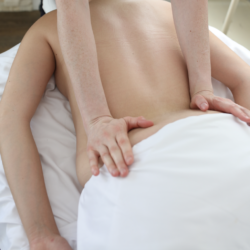
Muscle Base Technique
May 4, 2020 1:22 pmLinda Hoppe, a Canadian massage therapy instructor, created the muscle base technique concept to provide massage therapy students with a visual and tactile tool for more efficient tissue penetration.
It is essential to understand that therapeutic and relaxation types of massage exist simultaneously. When using more precise and deep tissue techniques, such as Effective Tissue Manipulation techniques, the therapist should achieve both local therapeutic effects and a general sense of relaxation. The two approaches to massage are not two opposite types and should always happen in conjunction. Regardless if it is a deep tissue massage or not, the massage should still be relaxing and not painful. The nervous system regulates muscle tone and motor activity. Whenever a massage therapist manipulates soft tissue, the nervous system reacts by letting go or contracting, depending on the nervous system’s interpretation of the stimulus as a threat or safety.
While doing Effective Tissue Manipulation, the muscle base comprises the surface beneath the manipulated soft tissue. It mainly consists of the client’s skeleton and the therapist’s hand when there is no hard, flat bony muscle base beneath the target tissue. An appropriate muscle base has to be solid, stable, and usually flat, plus it has to provide stability and comfort for the patient’s manipulated muscles. Large solid bones such as the femur, tibia, fibula, scapula, humerus, radius, and ulna are good examples of appropriate muscle bases. An inappropriate, dangerous muscle base is unstable, pointy, sharp, or edgy. The lateral aspect of cervical transverse processes, floating ribs, trachea, nerves, blood vessels, and unsupported bones are improper muscle bases. Any deep muscle compressions against such muscle base can damage the muscles and be very uncomfortable.
There are two significant components to consider when looking at tissue manipulation: the angle of muscle penetration and the deep tissue pressure, which are crucial in effective tissue manipulation.
The angle
The angle of muscle penetration is formed by the imaginary therapist’s body contact force of penetration and the muscle base plane located beneath the manipulated muscles. This angle needs to be close to 90o (force perpendicular to the muscle base plane) for maximum efficacy and greater penetration of a deep tissue massage. During a relaxation massage, the angle of tissue penetration is close to zero degrees, and the imaginary line vector and the muscle base plane become parallel.
The pressure
The muscle base is also a pressure guide for safe tissue penetration. The therapist will lean into the tissue until they feel the muscle base resistance with their contact surface. The muscle base end feel indicates that the therapist fully compresses the soft tissue against the hard surface, representing the safe tissue penetration threshold. From that point on, the therapist can adjust the pressure to the client’s need only by lightening up, releasing tension to a more comfortable level for the client, if needed. Pressing harder after reaching the muscle base will increase the central nervous system’s motor tone and sympathetic activation and create discomfort or even pain. The muscle base’s depth represents the most profound pressure applied to the muscles during Effective Tissue Manipulation techniques.
The muscle base continually changes, even underneath the same muscle or region. A muscle can anatomically rest on different structures, such as the posterior aspect of the ribs and the transverse processes. Therefore, the therapist must continuously adapt the therapeutic pressure and the sharp angle to provide the muscles with the optimal benefits of Effective Tissue Manipulation. In addition, the therapist must develop excellent tactile skills and be mentally present to react to the frequently changing muscle base tension beneath their fingers. Knowledge of anatomy will prevent working against inappropriate muscle bases and avoid hurting the client.
Muscle base technique
The muscle base technique massages soft tissue with controlled pressure adapted to the underlying massage base structures. Each muscle has its method.
Examples of muscle base
Infraspinatus muscle:
Infraspinatus fossa
Posterior aspect of the glenohumeral joint
Posterior and lateral humerus – as the muscle attaches onto the greater tubercle.
Rhomboids muscles:
Spinous processes of the thoracic spine
Lamina groove
Transverse processes
Costo-transverse joints
Posterior aspect of the ribs
Medial border of the scapula.
Biceps brachii muscle:
Radial tuberosity
Elbow joint
Anterior humerus
Bicipital groove
Glenohumeral joint
Upper trapezius muscle:
Back of skull
Upper cervical lamina groove
Upper ribs
Spine of scapula
Acromion
Clavicle
Quadriceps muscle:
Tibial tuberosity
Inferior and superior edges of the patella
Anterior femur
Levator scapula muscle:
Medial border of the scapula (or superior angle)
Ribs
Cervical laminae groove
Transverse processes of C1 to C4
By Linda E. Hoppe Bkin, TRP, RMT
Tags: Muscle base techniqueCategorised in: Blog, SFH Orthopedic Massage
This post was written by Dominique Hoppe
Comments are closed here.